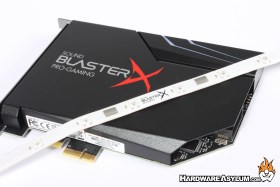Creative Sound BlasterX G6 7.1 External Gaming Audio DAC Review
Author: Dennis GarciaTesting the BlasterX G6
Given that I was already very familiar with the G5 I decided to test the Sound BlasterX G6 in a very similar manner. Testing was performed over a two week period where I used the Sound BlasterX G6 in conjunction with a Sound BlasterX H5 Gaming Headset. During this time I tried a variety of different settings all based on some of the default profiles and a few that I had created myself.
Overall I found the audio reproduction to be extremely good with excellent imaging both in virtual surround and standard stereo. Audio amplification was also very good as the built in amplifier drove the Blaster H5 Gaming Headset quite well.
32-Bit 384kHz playback is supported on Windows 10 using the latest Sound Blaster Connect driver. Unlike with some of the lower bit-rates you need to configure the playback using the Windows interface and have the BlasterX G6 configured in direct mode. That will bypass any Sound Blaster audio effects and send the smooth bit-rates directly to your ears.
Personally I prefer to have the audio effects enabled, at least when playing games, as it provided more audio depth when compared to the default windows audio, even at the higher bitrates.
During my testing period I also did a fun little test to see how well the Sound BlasterX AE-5 handled a standard gaming headset. Much to my suprise it was a night and day difference. The Blaster G6 handled 7.1 positional audio much better than the AE-5 (as it should) and really drove the idea home that if you normally play on headphones and want some excellent 7,1 positional audio you should really consider the Creative Sound BlasterX G6 over AE-5.
On the desktop the optical and multiple analog outputs are PERFECT for multi channel speaker setups and simply do not handle headphones as I would expect.
Basically the bottom line here is, purchase the device that works best for your system and situation knowing there are two very distinct differences.
No Audio review would be complete without a sound test and for this I used the RightMark Audio Analyzer. This test was performed using a loopback cable which is basically a jack that connects the analog line-out plug back into the analog line-in. That way we can remove almost all of the variables and concentrate on what is actually being reproduced and recorded.
Specs
Frequency response (from 40 Hz to 15 kHz), dB: +29.29, -102.43 - Very Poor
Noise level, dB (A): -136.6 - Excellent
Dynamic range, dB (A): 109.0 - Excellent
THD, %: 0.00941 - Very Good
THD + Noise, dB (A): -78.1 - Average
IMD + Noise, %: 0.038 - Good
Stereo crosstalk, dB: -62.9 - Average
IMD at 10 kHz, %: 3055.359 - Very Poor
General performance Average
For the RightMark test I disabled all of the audio processing and set the output to Stereo. Both input and output frequency responses were defaulted 24-Bit/48kHz which was then programed into RightMark.
The results tell an interesting story with an accurate dB(A) matching the BlasterX G6 specifications of 130dB and fairly good results across many of the other testing parameters. There are a couple of results that didn’t make much sense including Frequency Response and Intermodulation Distortion @ 10Khz. These seem to be comically high and is one reason why the overall audio is only “Average”.



